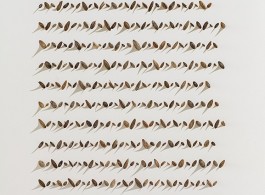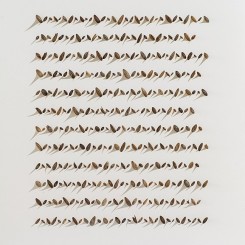Cui Fei: Tracing the Origin II
Exhibition Date: September 17 – November 20, 2016
Opening Reception: Saturday, September 17, 2016, 3–6 pm
Red No.1-D, Caochangdi, Chaoyang District, Beijing
Chambers Fine Art is pleased to announce the opening on September 17 of Cui Fei: Tracing the Origin II. Cui Fei was born in 1970 in Jinan, Shandong Province. After graduating from the China Academy of Fine Arts, Hangzhou, she moved to the United States in 1996 and has been resident there ever since.
Although painting was the primary focus in the first decade of her career, Cui Fei began to create works using materials from the natural world in the mid-1990s and this was soon to become the distinguishing feature of her artistic practice. She has described how the experience of being a Chinese artist in the United States and witnessing radical changes in China led to a heightened awareness of the relationship between man and nature that has been lost. “I see nature,” she has said, “as consistent and ordered, thus providing a therapeutic agent for healing and harmony in an otherwise chaotic world. I utilize materials found in nature such as tendrils, leaves and thorns composing a manuscript symbolizing the voiceless messages in nature that are waiting to be discovered and to be heard.”
Her work may thus be seen as an ongoing process of gathering materials from the natural world which she seeks out in different locations and seasons depending on the nature of the plants and of ordering and presenting them in a coherent manner in the privacy of her studio or in the public space of a gallery or museum. Each of the ongoing series of works that have preoccupied her for the last 15 years –Tracing the Origin series, Manuscript of Nature series, Read by Touch, Diary and others – has a different focus although the basic procedure remains the same.
In the current exhibition works from Read by Touch and Manuscript of Nature are notably different in impact. In the former thorns from black locust or honey locust trees and rose bushes are presented in horizontal lines representing units of time, the invitation to read by touch emphasizing the possibility of a painful encounter with the wickedly sharp thorns. There is a tension between the irregular forms of the thorns, each one unique, and the rigid way in which they are arranged.
In the latter, dried grape tendrils are aligned vertically, resembling Chinese calligraphy strokes written in grass style. Cui Fei has made many variations on this theme, presenting the material as framed works but also as installations in Manuscript of Nature V. In the latter the tendrils are pinned directly to the wall, the size of the work depending on the proportions of the space in which they are exhibited.
Another key work is Not Yet Titled in which individual units consisting of five thorns, four vertical and one horizontal tied together with twine, are attached directly to the wall of the exhibition space. As described in a recent analysis of Cui Fei’s work, “Each thorn represents one day, and the rows represent months. Each column is a year, or part of a year. Not Yet Titled counts out the duration of the second Sino-Japanese War, which lasted from 1937 to 1945. Every thorn represents another day of suffering. Looking at the tallies spread across the wall, one begins to take in how long that suffering lasted.”
In Cui Fei’s work there is always a tension between the found materials from the natural world that she uses as her medium and the methodical way in which this is presented whether in installations or independent works. Although she uses materials from the natural world rather than more traditional media, she explores themes that range from the personal and private to the universal.Chambers Fine Art is pleased to announce the opening on May 14 of Ten Thousand Things: New Works by Wu Jian’an.


